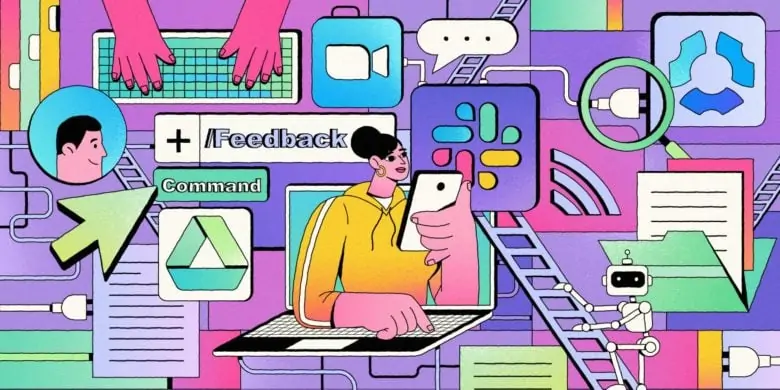Communication is the cornerstone of success for modern businesses. And here’s the deal: you need to master the ins and outs of different types of project management meetings.
Business projects are a constant interchange of information and updates. Multiple tasks need to be accomplished, many of which might be interlinked.
Recognizing this interdependence and understanding how to manage the process is key.
With so many moving parts and people, there’s only one way to keep a project running smoothly from start to finish: project management meetings.
This article breaks down the different types of project meetings and how to conquer them with some practical tips.
Boost your team’s efficiency with Hubstaff's productivity tools
10 types of project management meetings
1. Project management kickoff meetings
A project kickoff meeting is the first step toward aligning project goals.
This project meeting aims to introduce the team, understand the project background, and lay out what needs to be done from start to finish.
The kickoff meeting helps to establish project goals and understand how team members will work together to achieve them.
These meetings usually occur after contracts have been signed and there is a consensus on costs, timelines, and statements of work (SoW) with the client or decision-maker.
Every project is unique, but there are some basics you need to cover to start on a good note and get everyone on the same page.
I recommend following an agenda like this to familiarize everyone with each other and the challenges ahead.
Project kickoff meeting agenda template:
- Introductions: Explain why everyone is there and introduce any new team members. (15 mins)
- Review client background, if applicable: If this new project is for a client instead of for an internal project, this is the time to introduce the client, their industry, and their goals. (5 mins)
- Scope of the project: What are we doing, and why are we doing it? (25 mins)
- Approach: How will we get this done? (15 mins)
- Roles: Who will do what? How will we work together? (10 mins)
- Next steps: What should be done next, and by when? (5 mins)
- Q&A: Answer any questions standing in the way of team members getting started on their respective parts. (10 mins)
Remember:
As a project manager, you should already have a plan for the project kickoff meeting.
You are discussing it with the team only to get to nod and provide a context or sense of urgency for what’s coming next. You must be confident, motivating, and encouraging.

It’s also helpful to document the meeting or prepare meeting notes beforehand so you can send them to everyone involved for reference and guidance as the project progresses.
2. Project status meetings
Project status meetings keep the pace of the project.
Regular status review meetings not only keep people informed, but they also hold each role accountable for completing their part.
Try to keep to a fixed agenda and timeline with this meeting and systematically follow it to keep the team engaged and participating throughout.
Tangents make these meetings inefficient and unsuccessful.
Project status meeting agenda template:
- Review project schedule status: Acknowledge accomplishments and discuss what’s pending. Make sure the team understands the impact of delays and opportunities. (15 mins)
- Project scope status: Provide visibility into activities and events in the upcoming days and weeks. Give a quick run-through on pending action items. Discuss upcoming project milestones. (5 mins)
- Review the budget: Discuss how much has been spent compared with the original plan. (5 mins)
- Risk assessment: Invite team members to express concerns, raise issues, and get their input if they find certain things difficult to accomplish. (5-10 mins)
- Follow-up discussions: Identify points where a follow-up discussion is needed. Schedule separate meetings for those or delegate responsibility to someone to take the issue forward. (After the meeting)
Remember:
- Monday mornings are full of productive energy, and Friday afternoons are full of weekend daydreaming, which makes these times not ideal for conducting these (or any) meetings.
- Tuesdays around 2:30 pm is the most ideal time to meet with your team, as it’s still early in the week and falls at a time of day when people are still focused and productive. I can’t prove it, but there may be a special place in hell for project managers who schedule Friday afternoon meetings.

- Make sure everyone is engaged. If someone is not participating, encourage them to speak by asking questions. Over 39% of people doze off during meetings, while 91% admit to daydreaming. Engagement could keep these hurdles at bay.
3. Change control meetings
Let’s chat about change control meetings in the wild world of project management. Projects are like living organisms—they evolve, adapt, and sometimes throw you a curveball.
Here are our tips for change control meetings as a project team:
- Adapting to surprises: Change Control Meetings are where the project team gathers to face the unexpected. A client may want to tweak the scope, or an unforeseen hiccup may decide to join the party. Change control project meetings are the time to deal with those issues.
- Brainstorming solutions: Change control meetings aren’t just about identifying problems; they’re the brainstorming sessions of the project world. The team puts on their thinking caps to determine the best way forward. It’s like a project puzzle, and everyone contributes to finding the right fit.
- Getting everyone on the same page: Communication is the star of Change Control Meetings. Everyone spills the beans on how the change affects their part of the project. It’s about transparency, understanding, and getting everyone on the same page so the project ship sails smoothly, even in stormy waters.
- The paperwork: Change control project meetings are when you document everything—decisions made, action plans, and who’s responsible for what. It’s like creating a project diary telling how the project weathered the storms and emerged stronger.
So, in the grand scheme of project management, Change Control Meetings are the pit stops where the project team fine-tunes the strategy, tackles unexpected challenges, and keeps the project journey rolling. They’re not just about change but about steering change like a pro.
4. Sprint planning meeting
Sprint planning meetings are essential in Agile project management, particularly in Scrum methodology. These meetings set the stage for the upcoming sprint, defining what will be delivered and how the work will be achieved.
Here’s a breakdown of how to effectively conduct a sprint planning meeting:
Purpose of the Sprint Planning Meeting: The primary goal is to plan the work for the next sprint. This involves the Scrum team (including the Product Owner and Scrum Master) collaborating to define a sprint goal and selecting the user stories or tasks from the product backlog that will be tackled.
Sprint Planning Meeting Agenda:
- Sprint Goal Definition (15 mins): The Product Owner presents the objective or goal of the upcoming sprint. This goal guides the team in selecting and prioritizing tasks.
- Backlog Grooming and Task Selection (30 mins): The team reviews the product backlog, discusses each item’s complexity, and selects tasks for the sprint based on their priority and the sprint goal.
- Task Estimation (45 mins): Each task is discussed and estimated. Techniques like Planning Poker can be used for estimation, ensuring a collaborative approach.
- Sprint Capacity Planning (20 mins): Assess the team’s capacity, considering holidays, planned leaves, and other commitments. This helps in realistically determining how much work can be accomplished.
- Sprint Backlog Creation (30 mins): Finalize the sprint backlog, which includes all tasks and user stories selected for the sprint.
- Risk Identification and Mitigation (10 mins): Discuss potential risks and prepare mitigation strategies.
- Q&A and Finalization (10 mins): Address any questions and ensure everyone is clear about the sprint’s objectives and their responsibilities.
Key Points to Remember:
- Collaboration is Key: The meeting should be a collaborative effort where every team member has a say in the selection and estimation of tasks.
- Clarity on Roles and Responsibilities: Ensure that each team member understands their role and what is expected of them during the sprint.
- Flexibility: Be prepared to make adjustments. Agile is about adapting to change, and sprint planning is no exception.
- Time-Boxed: Keep the meeting within a set duration to maintain focus and efficiency (usually 2 hours for a two-week sprint).
Post-Meeting Actions:
- Distribute the Sprint Plan: Share the sprint plan with all stakeholders, including tasks, goals, and timelines.
- Update Project Management Tools: Reflect the sprint backlog in your project management tools for tracking and visibility.
Sprint planning meetings are not just about task allocation; they are about setting a clear, achievable goal and ensuring the team is aligned and motivated to deliver results. By following a structured approach, you can ensure these meetings are productive and set the tone for a successful sprint.
Remember, the effectiveness of a sprint planning meeting can significantly impact the success of the sprint, so invest the necessary time and effort to plan it well.
5. Agile Scrum meetings
An Agile framework, called Scrum, has become a popular method for managing projects.
This framework helps teams deliver value at short intervals. Fixed time iterations, called sprints, last 1-4 weeks. The purpose of Scrum meetings is to set yourself and your team up for the work ahead.
Scrum has roles, responsibilities, and meetings that are always the same.
- Product Owner
The PO is responsible for prioritizing and streamlining the Team Backlog (the list of tasks or projects yet to be started) and the execution of program priorities while maintaining the conceptual and technical integrity of the Features or components for the team. - Scrum Master
The Scrum Master runs Agile meetings. They ensure that the agenda is followed and that priorities and information are exchanged between participants to maximize time, flow, and engagement. Outside meetings, the Scrum Master clears roadblocks and keeps the team focused by responding to anything. - Scrum team
The Scrum team is, well, everyone on the team. It’s everyone working toward the successful completion of any given product, and it’s pretty much everyone in these meetings.
There are four obligatory components, also known as Agile Scrum ceremonies.
Before getting on to them, let’s understand the template for this Agile project management meeting.
Stand-up meeting agenda template: Spend 1-2 minutes per person
- Blockers: Is anything preventing contributors from getting work done? This includes technical limitations, personal setbacks, and departmental and team interdependencies.
- What did you do yesterday? Give a quick rundown on what tasks were accomplished the previous day, what didn’t get done, and why.
- What are your goals for today? How will each team member be accountable for the next day’s Scrum meeting?
- How close is the team to hitting the sprint goals? What do contributors feel about the pace of the sprint?
Remember:
- Try to hold them at the same time every day, and don’t be late!
- Keep the technology for the meeting consistent. There are plenty of Slack apps, bots, and tools like Flow, SoapBox, and Pocket that can help.
Now, it’s essential to understand the components of Scrum meetings since each holds incredible value for teams.
- Sprint planning: Sprint planning meetings give the Scrum Master a sense of who’s doing what. These meetings help provide perspective on the existing timeline and clarify what is pending.
- Daily Scrum or stand-up: The product owner and stakeholders participate in this meeting to answer questions raised by the team. Everyone is kept on the same page. For an Agile daily Scrum, we recommend following the agenda suggested above.
- Sprint/iteration review: How much work has the team accomplished in the last sprint? This session takes 1-2 hours, where stakeholders can give necessary feedback on the sprint demo. After the group provides a work progress demo, it receives stakeholders’ feedback.
- Sprint retrospective meeting: These meetings determine what went well and what didn’t throughout the sprint to improve the next sprint.

6. All-hands meeting
Alright, gather ’round because we’re diving into the world of all-hands meetings in project management. Think of these meetings as the project’s version of a team huddle – when everyone comes together, aligns their goals, and sets sail on the same project ship.
Here’s how we like to organize all-hands project meetings:
All hands meeting agenda
- Start with the big picture: These meetings are where the project manager unveils the big picture. What’s the project’s current status? Are we hitting our milestones? Any roadblocks?
- Check-in with the team: Ask questions like what’s next? What are the upcoming challenges and opportunities?
- Celebrate wins: Wins, big or small, take center stage in All Hands Meetings. Did a team member go above and beyond? Hit a project milestone? Cue the virtual applause.
- Q&A: Give everyone the chance to speak and ask their questions. A town hall-style meeting is a great time for your team to ask questions of their team leaders.
In project management, all-hands meetings are the glue that binds the team. They’re not just about updates; they’re about team spirit, shared visions, and creating a sense of belonging in the project journey.
7. Contingency planning meeting
Contingency planning meetings are strategic sessions for the project team members to anticipate and address potential challenges. These meetings act proactively, allowing the team to foresee and prepare for unexpected disruptions that could impact the project’s course.
The primary objective is to formulate alternative plans and document decision-making processes to ensure a swift and coordinated response when faced with unforeseen circumstances.
The resulting documentation becomes a vital resource, offering a structured guide for the team to navigate uncertainties and maintain project momentum.
Contingency planning meetings are not about pessimism but strategic preparedness. They provide a necessary layer of resilience, ensuring that the project team is equipped with actionable plans and responsibilities in the event of unexpected disruptions, fostering a proactive and adaptable project environment.
8. Stakeholder meetings
These meetings are usually for the most influential stakeholders, such as shareholders, partners, or senior leadership.
A well-organized meeting is critical to making a positive impression. Winning their attention and support is essential to your project’s success and future funding.
Here are some tips for conducting effective stakeholder meetings:
- Identify the appropriate stakeholders: High-touch communication can be reserved for top management, while others can be informed through emails.
- Stick to the agenda: Determine what issues you will discuss and how you will present them. Create a plan covering each portion of the meeting. Be clear about the questions you want to ask and discuss topics that will facilitate stakeholder feedback.
- Present project updates: Anticipate questions. Have all relevant metrics and documents handy to show the project’s progress. Determine what information you want them to have before the meeting begins.
- Seek feedback: Fully engage with the stakeholders and listen to their inputs or concerns.
Remember:
- Follow the agenda and stay within the schedule. These meetings tend to stray from vital points.
- Send a copy of the minutes to participants for follow-up. Encourage them to contact you and resolve any queries.
- Use efficient technology to increase engagement. Today’s presentations are way beyond PowerPoint. Use Learning Management System (LMS) tools that can allow them to graph information in real time or see visual content as they go.
Leading a remote team? Check out our helpful article on how to be as effective as possible.
9. 1:1 meetings
Let’s talk about 1:1 meetings as a project management team– they’re the secret to making projects tick. These one-on-ones between project managers and team members aren’t just your typical catch-ups; they’re all about team building and staying on the same page.
Project managers dive deep into each team member’s progress in these chats. We’re discussing celebrating wins, tackling challenges, and ensuring everyone’s on the same page with the project goals.
You can ask quickly for a project status report, but team collaboration and employee satisfaction are the real goals here.
Regular team meetings are great, but 1:1s allow managers to focus on the individual, not the team. Extra resources, clarity on goals, or skill-boosting? That’s what these one-on-ones are for – custom help tailored just for you.
10. Project review meetings
At the end of each project, you can engage with your team members by reviewing how the work unfolded. This gives insights into the strengths and weaknesses of the team and helps you plan better in the future.
Project review meeting agenda:
- Reiterate the objective: Reiterate the goals you and your team were working on, the duration of the project, and other details. (2 mins)
- Round table project update: Focus on each team member. What they found challenging, and what was the project’s high point. (15 mins)
- Focus on roadblocks and risks: This is to determine where the company stands on future projects. Focus on how to solve existing problems. (15 mins)
- Significant milestones: Celebrate accomplishments with the team. Applaud people who did exceptional work. (5 mins)
- Budget: Let the team know how much of the budget was utilized or whether any additional procurement was required. The team must understand the importance of meeting targets within a designated budget. (5 mins)
Remember:
- Don’t be afraid to reward your team. Whether it’s coffee and donuts or a team lunch, it’s essential to recognize good work.
Why meetings fail
It takes skill to conduct meetings that achieve the desired results. All too often, these meetings become unbearably ineffective and unpleasant for attendees. With a plan in place for every meeting, project goals are preserved, conversations can take a turn toward tangents, and everyone leaves feeling a little unaccomplished with no clear path forward.

In a survey of 182 managers across various industries, 65% said that meetings hinder their work, 71% stated that meetings are unproductive and inefficient, and 62% said they fail to bring the team closer.

If you lead teams, project management meetings could be one of the most powerful weapons in your arsenal.
But you need to know how to manage them.
The first step is to understand that there are various types of meetings, and choosing the right one could be the key to achieving your goals on time.

Set up every project for success with the right project management meeting
Whether you enjoy them or they’re the bane of your workweek, meetings aren’t going anywhere anytime soon.
Knowing this, meetings need to be optimized since time is precious and everyone is bound to tight schedules.
By choosing the right type of meeting to hold and sticking to an agenda, your team will feel more productive instead of feeling like they’re wasting their time. Ensuring meetings aren’t something your team dreads is another milestone in the career of a project manager.
Streamlined Agile project management tools can help you achieve such a feat quickly. Keep projects moving with automated workflows, Stand-ups, Sprints, and tracking tools to help save time and promote engagement throughout every project phase.
Did you find this article helpful? If you did, hit share or tweet us and let us know your best meeting tips.
Subscribe to the Hubstaff blog for more posts like this
Most popular
The Fundamentals of Employee Goal Setting
Employee goal setting is crucial for reaching broader business goals, but a lot of us struggle to know where to start. American...
Data-Driven Productivity with Hubstaff Insights: Webinar Recap
In our recent webinar, the product team provided a deep overview of the Hubstaff Insights add-on, a powerful productivity measurem...
The Critical Role of Employee Monitoring and Workplace Security
Why do we need employee monitoring and workplace security? Companies had to adapt fast when the world shifted to remote work...
15 Ways to Use AI in the Workforce
Whether through AI-powered project management, strategic planning, or simply automating simple admin work, we’ve seen a dramatic...





